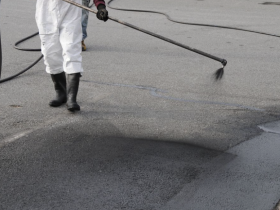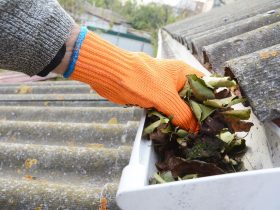Historical Use of Asbestos in Window Frames
Asbestos, known for its durability and fire resistance, was once a popular choice in construction. This includes its use in window frames, particularly in homes built before the 1980s. Back then, asbestos was added to materials like putty and caulking to improve insulation and fireproofing. It wasn’t until later that the health risks became widely known. Asbestos use in window frames was common, especially in older homes, where it helped seal and insulate the windows.
Common Locations of Asbestos in Windows
In windows, asbestos can typically be found in:
- The putty used to seal the window glass to the frame.
- The caulking around the window edges.
- Insulation materials within the window frame itself.
These materials were chosen for their ability to resist heat and prevent drafts. However, they pose a risk if disturbed, such as during renovations or window replacements.
Health Risks Associated with Asbestos in Windows
The primary concern with asbestos in window frames is the potential release of fibers into the air. When asbestos-containing materials are disturbed, they can become friable, meaning they crumble easily and release fibers. Inhaling these fibers can lead to serious health issues, including asbestosis, lung cancer, and mesothelioma. Guidance on identifying and managing asbestos is crucial for homeowners, especially those in older properties.
Understanding these risks is essential for anyone living in or renovating an older home. By recognizing the presence of asbestos in window frames, homeowners can take appropriate measures to protect their health and that of their families.
Can Asbestos Exposure Happen from Home Window Frames?
Identifying Asbestos in Window Frames
Asbestos in window frames isn’t always easy to spot. Often, it’s hidden in the insulation or the caulking between the frame and the wall. If your home was built before the 1980s, there’s a chance asbestos might be lurking there. It’s crucial to identify these materials before any renovations. Professionals can help test and confirm the presence of asbestos, ensuring safety during home projects.
Potential Health Implications
When asbestos-containing materials in window frames are disturbed, fibers can be released into the air. Inhaling these fibers poses serious health risks, such as lung diseases and cancers. Here’s a quick rundown of potential health issues:
- Asbestosis, a chronic lung disease causing scarring of lung tissue.
- Mesothelioma, a rare cancer associated directly with asbestos exposure.
- Lung cancer, with increased risk for smokers exposed to asbestos.
Preventive Measures for Homeowners
Homeowners should take several steps to minimize asbestos risks:
- Conduct thorough asbestos testing before starting any renovations (Renovations can disturb asbestos).
- Hire certified professionals to handle and remove asbestos safely.
- Avoid DIY projects involving old window frames unless you are sure they are asbestos-free.
By taking these precautions, homeowners can significantly reduce the risk of asbestos exposure from window frames.
The Role of Asbestos in Window Putty and Caulking
Why Asbestos Was Used in Window Putty
Asbestos was commonly used in window putty due to its fire-resistant and strengthening properties. This made it an ideal component in building materials, particularly in older homes. The putty not only helped retain heat but also provided a robust seal against drafts and moisture. Some types of asbestos-containing putty were intumescent, meaning they would swell when exposed to heat, offering an additional layer of fireproofing.
Risks of Deteriorating Asbestos Putty
Over time, window putty can deteriorate, especially in older homes, leading to potential asbestos exposure. As the putty ages, it may crack or crumble, turning into a friable material that can release asbestos fibers into the air. This poses significant health risks, particularly when the putty is disturbed during renovations or window replacements. It’s crucial to handle any suspected asbestos-containing materials with care to avoid health hazards.
Safe Handling of Asbestos-Containing Putty
If you suspect your window putty contains asbestos, it’s important to follow safety guidelines to minimize exposure risks:
- Conduct a visual inspection to check for signs of deterioration.
- Avoid disturbing the putty unless absolutely necessary. If work is required, consider hiring professionals who specialize in asbestos abatement.
- If you decide to handle it yourself, ensure you’re using protective gear such as masks and gloves, and follow guidelines for building maintenance to safely perform non-licensed work with asbestos.
Health Risks of Asbestos Exposure from Window Frames
Respiratory Issues Linked to Asbestos
Asbestos exposure primarily affects the respiratory system, leading to a range of health complications. When asbestos fibers are inhaled, they can lodge in the lungs and cause inflammation. This inflammation can eventually lead to serious respiratory conditions. Some common issues include:
- Asbestosis, a chronic lung disease that causes scarring of lung tissue and shortness of breath.
- Pleural plaques, which are areas of fibrous thickening on the lining of the lungs or diaphragm.
- Chronic obstructive pulmonary disease (COPD), which can be exacerbated by asbestos exposure.
Long-Term Health Effects
The long-term health effects of asbestos exposure can be severe and often take years to manifest. The most concerning risks are:
- Mesothelioma, a rare and aggressive form of cancer that affects the lining of the lungs, abdomen, or heart.
- Lung cancer, which can develop after prolonged exposure to asbestos fibers.
- Other cancers, such as those affecting the larynx or ovaries, have also been linked to asbestos exposure.
These conditions have a long latency period, meaning symptoms may not appear until decades after exposure.
Vulnerable Populations
Certain groups are more susceptible to the health risks associated with asbestos exposure. These include:
- Individuals who have worked in industries with high asbestos use, such as construction or shipbuilding.
- People living in older homes where asbestos-containing materials, like window frames, may be present.
- Families of workers who may have brought asbestos fibers home on their clothing.
Recognizing these vulnerable populations is important for targeting preventive measures and ensuring early detection of asbestos-related diseases.
Guidelines for Safe Asbestos Management in Windows
Conducting an Asbestos Survey
If you’re dealing with older windows, especially those installed before 2000, it’s wise to start with an asbestos survey. This step is crucial to identify any asbestos-containing materials (ACMs) before beginning renovations. A professional survey will pinpoint the exact locations of asbestos in window frames and assess its condition. If the asbestos is undisturbed and in good shape, it might not be an immediate threat. However, any renovation plans should take potential asbestos disturbance into account.
Professional Asbestos Removal
Once asbestos is confirmed, the safest route is hiring licensed professionals for removal. These experts have the training and equipment needed to handle asbestos without releasing fibers into the air. Choosing the right contractor is key, so look for those with proper certifications and a solid track record. They will ensure that asbestos is removed safely and in line with legal standards.
DIY Precautions and Safety Tips
For those considering a DIY approach, extreme caution is necessary. Avoid using high-speed tools like sanders or drills on materials that might contain asbestos. Instead, opt for hand tools that minimize dust. Always wear protective gear, including masks and gloves, to reduce exposure. Before starting any work, it’s advisable to consult with a professional to understand the risks and necessary precautions. For safety during renovations, consider eye protection and other protective gear to shield against asbestos fibers.
Legal and Regulatory Aspects of Asbestos in Homes
Understanding Asbestos Regulations
Navigating the legal landscape surrounding asbestos can be tricky, especially for homeowners. In April 2019, a final rule was established to protect the public from asbestos by prohibiting its uses that are no longer available in the market and not regulated by other laws. This rule highlights the ongoing efforts to minimize asbestos exposure risks. Homeowners should be aware that any renovation or demolition work in older homes may require adherence to specific regulations to ensure safety and compliance.
Homeowner Responsibilities
Owning a home that might contain asbestos carries certain responsibilities. Asbestos was widely used in homes constructed prior to the 1980s, making it crucial for homeowners to identify and manage any asbestos-containing materials (ACMs). It’s important to conduct an asbestos survey before starting any renovation projects. This not only ensures the safety of the inhabitants but also aligns with legal requirements. Here are some key responsibilities:
- Identify Potential Asbestos: Ensure that any suspected materials are tested by professionals.
- Comply with Legal Standards: Follow local and national regulations regarding asbestos management.
- Engage Certified Professionals: Hire certified asbestos abatement professionals for removal or disturbance of ACMs.
Legal Implications of Asbestos Exposure
Failure to adhere to asbestos regulations can lead to significant legal consequences. Homeowners may face fines or legal action if asbestos is improperly handled or if exposure risks are not mitigated. Moreover, if a property is sold without disclosing the presence of asbestos, the seller could be held liable for any resulting health issues or devaluation of the property. Thus, understanding the legal implications is not just a matter of compliance but also of protecting one’s financial and personal interests.
Professional Asbestos Testing and Abatement
Choosing a Certified Asbestos Professional
When it comes to asbestos testing and removal, selecting the right professional is key. Hiring a certified asbestos professional ensures the job is done safely and correctly. Look for experts who are ARCA accredited and have a Hazardous Waste Collection Permit. They should have full asbestos removal insurance. Don’t forget to check customer reviews to gauge their service quality. Companies like this one offer testing services to identify asbestos in your home, making sure you’re not exposed to hidden dangers.
Testing Procedures for Asbestos
Testing for asbestos is not something you should take lightly. A professional will typically start with a visual inspection of the suspected areas. Samples are then collected and analyzed in a lab to confirm the presence of asbestos fibers. It’s a meticulous process that requires specialized knowledge and equipment. The EPA asbestos site is a great resource for understanding the risks and procedures involved in asbestos testing.
Abatement and Removal Techniques
Once asbestos is confirmed, the removal process begins. It’s crucial to follow strict safety protocols to prevent asbestos fibers from becoming airborne. Professionals use techniques like wetting materials to minimize dust and carefully sealing off areas to prevent contamination. They also use specialized equipment to safely remove and dispose of asbestos materials. The entire process is regulated to protect both the workers and the inhabitants of the home. Always ensure that the company you choose adheres to these safety standards.
Common Misconceptions About Asbestos in Windows
Myths About Asbestos Safety
There’s a widespread belief that small amounts of asbestos are harmless, but this couldn’t be further from the truth. Even minimal exposure to asbestos can be detrimental to your health, particularly affecting the lungs. Many assume that asbestos only poses a risk under certain conditions, like during renovations or when the material is visibly damaged. However, asbestos fibers can be released into the air even with slight disturbances, highlighting the need for greater awareness about the dangers of asbestos exposure. For more information on asbestos exposure risks, it’s crucial to understand that any exposure, regardless of the amount, can be harmful.
Misunderstandings About Asbestos Removal
Another common misconception is that asbestos removal is a simple DIY task. In reality, safely removing asbestos requires professional expertise and specialized equipment. Homeowners often underestimate the complexity involved in handling asbestos-containing materials. Without proper precautions, attempting to remove asbestos can lead to significant health risks. During renovations or construction, asbestos mixtures can be disturbed, releasing harmful fibers into the air. It’s essential to consult with certified professionals to ensure safe and effective asbestos abatement.
Clarifying Asbestos Regulations
Many people are unaware of the stringent regulations governing asbestos handling and removal. These regulations are in place to protect public health and ensure that asbestos is managed safely. Homeowners may mistakenly believe that these regulations are overly cautious or unnecessary, but they play a critical role in preventing asbestos-related illnesses. Understanding these regulations can help homeowners make informed decisions about managing asbestos in their homes, ensuring both safety and compliance with legal standards.
Steps to Take if You Suspect Asbestos in Your Windows
Initial Assessment and Identification
If you suspect asbestos in your window frames, the first step is to avoid disturbing the material. Asbestos is hazardous when its fibers become airborne, so it’s crucial to handle the situation carefully. Start by visually inspecting the window putty or caulking for signs of aging or damage. If the putty looks brittle or crumbly, it might contain asbestos. Homes built before the 1980s are more likely to have asbestos-containing materials. If you’re unsure, it’s best not to take any chances.
Consulting with Experts
Once you’ve identified potential asbestos, it’s time to get professional help. Contact a certified asbestos surveyor to conduct a thorough inspection. They have the tools and expertise to safely test and confirm the presence of asbestos. Expert guidance is crucial because improper handling can increase health risks. Professionals can assess the situation and recommend the safest course of action.
Planning for Safe Removal
If asbestos is confirmed, you’ll need to plan for its safe removal. Engage a certified asbestos abatement professional to handle the removal process. They use specialized techniques to ensure that asbestos fibers are not released into the air. Follow their guidance and ensure the area is sealed off during the removal. Remember, safety is paramount, and professional handling is essential to prevent exposure. In some cases, contacting a certified asbestos surveyor immediately is necessary to manage the situation effectively.
The Importance of Regular Window Maintenance
Signs of Deteriorating Window Putty
Keeping an eye on your window putty is more important than you might think. Deteriorating window putty can be a sign of underlying issues that could lead to bigger problems down the road. Look for cracks, gaps, or pieces that are starting to crumble. These are clear indicators that the putty is not doing its job anymore. This is especially true for older homes where asbestos might have been used in the putty.
Preventive Maintenance Tips
Regular maintenance can save you a lot of hassle and money. Here are a few tips to keep your windows in top shape:
- Inspect regularly: Check your windows for any signs of damage or wear, especially after harsh weather conditions.
- Clean thoroughly: Use a mild detergent and water to clean the window panes and frames, avoiding abrasive materials that can scratch or damage the surfaces.
- Seal any gaps: Apply new sealant or putty to areas where the old material has worn away, ensuring to use materials that don’t contain asbestos.
When to Consider Window Replacement
Sometimes, maintenance isn’t enough, and replacement becomes necessary. If your windows are drafty, hard to open, or the frames are rotting, it might be time to think about getting new ones. Not only will this improve your home’s energy efficiency, but it will also reduce the risk of exposure to hazardous materials like asbestos. Remember, effective moisture management and routine inspections are essential for minimizing health risks associated with mold and asbestos in older windows. Engaging professional services can further enhance safety and ensure a healthier living environment.
Impact of Weathering on Asbestos-Containing Materials
How Weathering Affects Asbestos
Asbestos, known for its durability, doesn’t last forever. Over time, natural weathering can cause asbestos materials to break down. When it comes to asbestos cement roofing, the effects of weathering are significant. Rain, wind, and temperature changes can slowly erode the material, turning it from a solid state into a more friable, or crumbly, form. This transformation increases the risk of asbestos fibers being released into the air, posing potential health risks.
Risks of Weathered Asbestos Putty
In older homes, window putty might contain asbestos, which was added for its fire-resistant properties. As the putty ages, it becomes brittle and may crack or crumble. This deterioration is a real concern because it can release asbestos fibers into the air. Homeowners should be aware that even minor renovations or window replacements can disturb this material. Inhaling these fibers is hazardous, as asbestos exposure is linked to serious health issues, including cancer.
Protective Measures Against Weathering
To minimize the risks associated with weathered asbestos materials, consider the following steps:
- Regular Inspections: Conduct frequent checks on areas where asbestos might be present, like window frames and roofs, especially if your home was built before the 1980s.
- Professional Assessment: If you suspect asbestos, hire a certified professional to assess the condition of the materials. They can determine if the asbestos is still intact or if it has become friable.
- Safe Handling and Removal: If removal is necessary, it should be done by professionals trained in asbestos abatement to ensure safety. Attempting to remove asbestos yourself can lead to accidental exposure.
By understanding the impact of weathering on asbestos, homeowners can take proactive steps to protect their health and maintain their property’s safety.
Reference Materials











